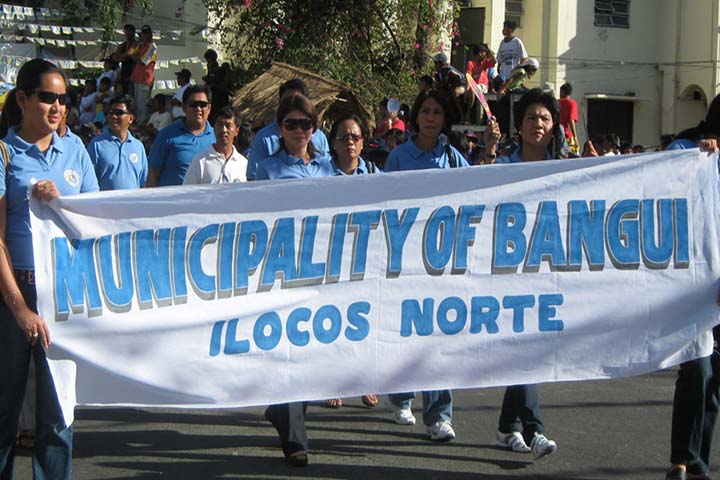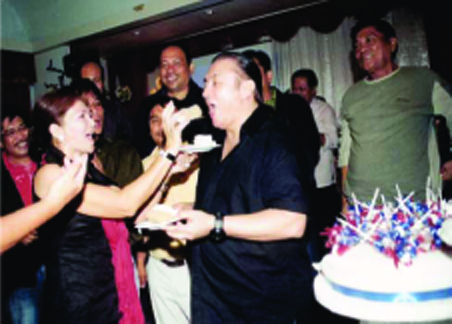
Cadagitoy napalabas nga aldaw, nakisinnucatac iti email ken ni Dr. Aurelio S. Agcaoili, tubo ti ciudad ti Laoag ken nagturpos iti University of the Philippines, premiado a mannurat, lider ti gunglo ti NAKEM, maysa cadagiti sagat nga adigi ti panangparang-ay iti Ilocano ken agdama a Coordinator ti Programa a Pagsasao ken Kur-itan nga Ilocano, Departamento dagiti Pagsasao ken Kur-itan nga Indo-Pacifica, Universidad ti Hawai’i iti Manoa:
Sunday, January 25, 2009, 11:23AM
Patgec nga Ariel: Annugotec nga akikid ti focus ti blog co, ibangui.wordpress.com, isu ngarud nga umay ca man singaen ken ruroden bareng mapan mo usisaen no ania ti pagcurangan dagiti dua a naudi nga impaskin co sadiay.
Yamanec unay ti ania a criticism nga ipaaymo, Cabsat.
Agraem, —Manong Joe
Monday, January 26, 2009, 4:36PM
Patgek a Manong Joe: Dinardarasko a sinirpat ti blogyo gapu ta ammoc nga adu ti maadal ken maagsaw. Ket agpayso! More, more! —Ariel
Monday, January 26, 2009, 6:45PM
Dear Ariel: Thanks for taking the time to humor me. One thing I was painfully aware of was that the rhetoric was terribly inadequate. I know you have more ammo in your arsenal. By all means, let’s use ’em.
The all too enervating reality in what we are trying to do to save Ilocano is the crippling silence of a lot of our fellow Ilocanos who are in a position to see to it that we don’t witness the eventual, albeit slow demise of our language. —Manong Joe
Monday, January 26, 2009, 7:09PM
Manong Joe: Dayta ngarud, Apo Joe, ti pagsaksakitan ti nakem ti adu kadatayo iti daytoy a tignayan. Dagiti pangnamnamaantayo a makatulong iti daytoy a tignayan, awanda. Ngem ala, aramid daytoy a kultural, aramid a pulitical, ken aramid a kabulig ti ranget ken pannakiranget, iti man bukod a bagi, iti man kailian/kailokanuan, ken/wenno iti sabali pay. Sapay ta agballigitayo.
Maysa a panagsaludar kenca, —Ariel
Tuesday, January 27, 2009, 9:25AM
Patgec nga Ariel: Kinaagpayso na, lacayacon ngem agsipud ta nabayagen a nagtaeng ditoy agdama nga ayanco, nairuamacon a maibilang a cadawyan wenno ordinario laeng (nga isu ti kinaagpaysona) isu nga agalumiimac nga awagam iti “Apo”. Isu a pangngaasim ta isardengmo ti panangawagmo caniac iti “Apo”. Caniac a maysa, ni Apo Dios laeng ti rebbengna a maawagan iti Apo.
I know that the move to invigorate Ilocano, such as envisioned in the Gunigundo Bill, requires funding. However, being this poor rat, I can’t help much in that aspect. So who can we turn to as our patrons who would not be squeamish about unloosing their power, influence and financial resources to keep the fight alive and kicking and focused laser-sharp to getting the desired results and eventually winning the fight for multilingual education? Maybe your NAKEM group could come together and formulate a strategy focused on this Gunigundo Bill in particular and, in general, on placing Tagalog on an equal footing with the other major local languages such as Ilocano, Cebuano, Bicol, etc., CERTAINLY NOT as the favored language which is lording it over the other languages at such a costly sacrifice of losing these non-Tagalog languages forever–maybe not in our lifetime but forever any way such as we have witnessed happen with other languages that died.
In other words, here’s your chance, Ariel, to have your group fashion a formidable Ilocano language movement manifesto that has a backbone and muscle to bring about the needed results in much the same manner as the Tagalistas took advantage of the corridors of power to have Tagalog declared as the pseudo “national language”. As I wrote you earlier, I really don’t mind having English as the national language, as indeed it is now constitutionally, being that it is is also the global lingua franca, and have the other local languages thrive equally with Tagalog in the spirit of the Gunigundo Bill. Earlier in the mid 1900s, we relished the perception that we had the highest percentage of our population who spoke English with a high literacy rate to boot until the Tagalistas, with their hidden agenda of effectively colonizing the country themselves, came along on the coattails of a Tagalog-speaking president and a swath of Tagalog cohorts in high places. The rest of us Ilocanos, Cebuanos, Bicolanos, Pampanguenos Hiligaynons, Pangasinenses, Warays, etc., stood by almost completely mesmerized and scarcely lifted a finger at the coming demise of our respective languages, cultures and unique bodies of literature. WE WERE SO UTTERLY TRUSTING AND DUMB THAT UNTIL NOW NOT VERY MANY AMONG US KNEW AND UNDERSTOOD OR EVEN CARED TO UNDERSTAND WHAT HIT US.
History has clearly demonstrated again and again that people with distinctly unique languages/dialects tend to gravitate to the language vigorously propagated by governments as the language of commerce for purely economic or survival reasons. And that, as you and I know, is what’s happening to the non-Tagalog languages in the Philippines. The increasing use of Tagalog and the conversely decreasing use of the others can only spell out a sure consequence, namely, the demise of the non-Tagalog languages.
Someone wrote: “Ethnic genocide is the destruction of a culture. You can compare it to a living being who is born, lives, and dies. If he dies a natural death after a long and beautiful life, very well. But if we kill him, or we don’t help him when he is in danger, that’s something else… It’s the same with languages in danger of extinction.”
I was kind of hoping that Bannawag, Tawid NewsMagasin, and other Ilocano publications of note, Ilocano writers and Ilocano bloggers would show some energy to carry the torch. But I believe most of them find no immediacy to the attendant issues. There just seems to be an incredible amount of apathy toward preserving one’s mother tongue simply because the people who dictate policy and who care to influence the Constitution are brainwashed about the imposition of Tagalog (which was not even the language of the majority at the time) as one of our national languages. We seem to fail to see that government is just a bunch of people like the rest of us–with their own sellfish agenda. At this point in time, the Tagalogs just seem to have more energy and determination to assert themselves to colonize the rest of us who, to their undisguised eleation, are mere uncomplaining sacrificial lambs waiting to be butchered and skewered. —Manong Joe
Tuesday, January 27, 2009, 11:11AM
Dear Ariel: Please don’t get tired of the repetitious messages coming from me. I suppose you don’t need them. But what’s important is for you and the rest of us to keep repeating the message until something like the ground beneath our feet shifts in our favor. We’ve got to keep pounding the message:
“What matters is not the death of a language in itself, but what that death can bring: When a language disappears, a whole way of thinking, a vision of the world disappears with it, which can only impoversih human culture and the capacity of people to understand the world around them.”
We are nearing the threshold of inevitability of Ilocano being supplanted entirely by Tagalog/Filipino. We can no longer afford to waste our chances. NOW IS THE TIME TO FIGHT BACK AND ASSERT OUR RIGHTS TO THE USE AND PRESERVATION OF OUR NATIVE TONGUE, OUR CULTURE, OUR LITERATURE, OUR HERITAGE.
If we don’t, the time will come when the agcamcam (the new Tagalog colonizers) among us don’t even need the obligatory or deferential but insulting and despicable “Okinnam, okinnam…” —Manong Joe
Tuesday, January 27, 2009, 11:13AM
Manong Joe: Wen, ngarud: nakakaskas-ang. Adu dagiti Tagalista a maibilang a kabusor daytoy numo ngem diak agalumiim. Kinaagpaysuanna, profesorko pay ti maysa kadakuada. Ngem saan a mabalin daytoy, Manong Joe. Masapul ti nanakman a dangadang–ken masapul ti kinaregget a kankanayon, a no dadduma ket agmawmaw met. Mabannog ti puso, madudog ti kararua nangruna no ti makita ket dagiti pada met a nengneng a dida met ammo ti lablabidenda. Anian! Ngem saan a gasat daytoy: daytoy ket resulta ti saan nga umno a panagsirmata ken kinaawan panagparmata iti masakbayan. Awan pabasolen no di met laeng datayo. Saan a gasat, saan a ti sabali tapno iti kasta ket makasursurotayo a makibalubal iti nagan dagiti fundamental a karbengantayo. —Ariel
Tuesday, January 27, 2009, 11:33AM
Patgec nga Ariel: Idi nagawidac iti daytay napalabas a Marso, dimo ngata patien ngem casla adda pimmusay a parte ti kina-Ilocanoc idi sungbatandac iti Tagalog tunggal nakisaritaac iti Ilocano cadagiti pada nga Ilocano iti amin a nagpasiarac idiay Ilocandia, agraman dagiti cailian idiay Bangui.
Dayta ti dackel a paggiddiatan ti caadduan cadagiti pada nga Ilocano dita Hawaii. Iti daydi naudi a panagpasiarco dita Hawaii, napaliiwco a lumawag ti rupa ken macaisem dagiti Ilocano no casaritam ida iti Ilocano, uray pay no dimo am-ammo ida–sadiay Honolulu wenno Hilo airports, idiay USS Arizona Memorial Park, Ala Moana Center, wenno idiay Waikiki Beach. Nadlawco dagiti pada nga Ilocano nga ibaw-ingda ti panagkitada kenca apaman a mangegda nga ag-Ilocano ca.
Sal-ut a biag! —Manong Joe
Tuesday, January 27, 2009, 12:03PM
Manong Joe: Daytoy, Manong Joe, ti empirikal a datos a mismo a nakitam. Isu nga agung-ungetakon. Ket iti NAKEM Conference idiay Batac idi 2007, diak nagawidan ti ngiwngiwko ket imbagak nga estupido ti pagannurotan ti govierno maipapan iti edukasion, kultura, ken lengguahe–a nengneng a padak dagiti agpatpataray iti sistema ti educasion. Iti tallaong nga imbagak dayta. No dadduma, masapul a kulibagtongem dagitoy pada nga Ilokano a sinalbag.
Ala, makapaunget nga agpayso. Idi agsubli dagiti nagbakasion a fakultimi, kasta met ti imbagada ken nagung-ungetda met ta agin-Tatagalog kano met dagiti mamaestro ken mamaestra. Pwe, kunam man! —Ariel
 Ipacdaarmi ditoy ti awis ni Roy S. Padre, mangidaulo iti Banguinians ti Southern California, a makitipon iti Bangui High Reunion 2010 a maangay iti May 2010 segun ti naipablaac nga invitation ken itinerary iti baba, ken casta met a makitipon iti Bangui High Alumni Network, ti sangalubongan a gimong dagiti nagturpos iti dati a Bangui Provincial High School nga isu itan ti Bangui National High School nga addaan campus iti Banban, Poblacion, ken Lanao.
Ipacdaarmi ditoy ti awis ni Roy S. Padre, mangidaulo iti Banguinians ti Southern California, a makitipon iti Bangui High Reunion 2010 a maangay iti May 2010 segun ti naipablaac nga invitation ken itinerary iti baba, ken casta met a makitipon iti Bangui High Alumni Network, ti sangalubongan a gimong dagiti nagturpos iti dati a Bangui Provincial High School nga isu itan ti Bangui National High School nga addaan campus iti Banban, Poblacion, ken Lanao.



 The list of uses of solar power includes: calculators with a small solar cell, solar battery chargers to recharge cell phones, Ipods, laptop computers and other small devices, solar panels known also as photovoltaic cells that transform the sun’s energy to electricity. The more common use of solar power is of the residential variety–providing electricity for homes. In the latter case, solar panels are installed on the roof (photo at left) or on the ground and the electricity produced feeds a battery bank and an inverter providing 110 or 220 volts for the home. Other popular solar devices using solar technology are solar lights, solar fountains, solar pumps, solar refrigerators (ama, nalamlamuyot ngata ti ayus tay impalamiis a basi!), solar water heaters and
The list of uses of solar power includes: calculators with a small solar cell, solar battery chargers to recharge cell phones, Ipods, laptop computers and other small devices, solar panels known also as photovoltaic cells that transform the sun’s energy to electricity. The more common use of solar power is of the residential variety–providing electricity for homes. In the latter case, solar panels are installed on the roof (photo at left) or on the ground and the electricity produced feeds a battery bank and an inverter providing 110 or 220 volts for the home. Other popular solar devices using solar technology are solar lights, solar fountains, solar pumps, solar refrigerators (ama, nalamlamuyot ngata ti ayus tay impalamiis a basi!), solar water heaters and 



 Açaí (Euterpe oleracea), the wonder palm tree that thrives along the Amazon river in South America and bears these wonderful fruits that look like berries which are made into different food, drink, dietary supplement and medicinal products, is undergoing a phenomenal intro into the international consciousness. As usual, in their the desire to make fast money out of these super berries, the network marketing and multi-level marketing (MLM) people handling the promotion of açaí products tend to hype their myriad food and medicinal uses with as much credibility as the boy who cried “Wolf!” So much so that when one Googles “açaí”, more than half the search results which look promising at first blush are actually redirects to a website selling acai dietary pills.
Açaí (Euterpe oleracea), the wonder palm tree that thrives along the Amazon river in South America and bears these wonderful fruits that look like berries which are made into different food, drink, dietary supplement and medicinal products, is undergoing a phenomenal intro into the international consciousness. As usual, in their the desire to make fast money out of these super berries, the network marketing and multi-level marketing (MLM) people handling the promotion of açaí products tend to hype their myriad food and medicinal uses with as much credibility as the boy who cried “Wolf!” So much so that when one Googles “açaí”, more than half the search results which look promising at first blush are actually redirects to a website selling acai dietary pills.
 kinabileg ti pagsasao a pangparucma iti cayat a parmeken. Nadlawmo nga iti canito (agarup 94 seconds calpasan panangrugi ti
kinabileg ti pagsasao a pangparucma iti cayat a parmeken. Nadlawmo nga iti canito (agarup 94 seconds calpasan panangrugi ti 
 English Pronunciation Power Course.
English Pronunciation Power Course.